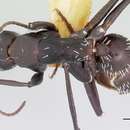en
names in breadcrumbs


Extant: 1 valid subspecies
Camponotus niveosetosus Mayr, 1862 PDF: 665 (w.) SOUTH AFRICA. Afrotropic. AntCat AntWiki HOLTaxonomic history
Mayr, 1866b PDF: 885 (q.); Forel, 1891c PDF: 41 (s.); Arnold, 1922 PDF: 659 (m.).Combination in Camponotus (Myrmoturba): Forel, 1914a PDF: 267.Combination in Camponotus (Myrmepomis): Emery, 1920b PDF: 259.Combination in Camponotus (Myrmopiromis): Wheeler, 1922: 986.Wien. Zool. Boi Ges. 1862, 665.
Keren (Beccari); [[ worker ]] [[ queen ]].
Rinvenuto al Capo di Buona Speranza.
- Cape Town.
Femina: Long, capitis et thoracis 6 mm. (corporis forsan circa 10 mm.). Micans, nigra, mandibulis, genarum margine antico, funiculo tarsisque castaneis; sparse albido-pubescens; caput et thorax antice sparse pilosa, metanoti latera copiosius pilis, niveis setaceis, abstantibus; caput et thorax densissime et subtiliter reticulato-punctata, genae insuper punctis majoribus conspersae; clypeus non carinatus; margine antico rotundato; alae paulo infuscatae, costis fuscis, pterostigmate fusco-nigro.
Nach einem mangelhaften Exemplare im k. k. zoologischen Hofcabinete.
[[ worker ]] Laenge: 6 - 8 mm. Schwarz, Fuehler und Tarsen braunroth, die Mandibeln dunkel rothbraun. Der Koerper mit sehr spaerlicher, anliegender, weisser Pubescenz. Die Oberseite des Koerpers mit aufrechten, schneeweissen Borsten versehen. Der Kopf und Thorax sind aeusserst fein und dicht punctirt, der Hinterleib aeusserst fein und dicht quergestreift. Der Clypeus hat keinen Mittelkiel und einen bogig vortretenden Vorderrand.
Von der Novara-Expedition vom Cap der guten Hoffnung mitgebracht.
[[ worker ]]. Fundnotizen: Insel Fundu (W. Pemba). Gross-Comoro.
Camponotus niveosetosus, commonly known as the hairy sugar ant, is one of the smaller species of sugar ant. It is native to an extensive region in the eastern Afrotropics.
They are dark grey to black in colour, with tellingly, copious stiff, almost snow-white hairs on the thorax and gaster.[1] The antennae and tarsi are ferruginous, and the mandibles dark castaneous red.[2] In addition to the thick and blunt white pilosity it is covered with a more yellowish, short and fine, decumbent pubescence.[2]
They are found from Kenya to South Africa in a variety of habitats.[3][4] Only arid regions seem to be avoided. They are found in gardens, fynbos, grassland, savanna and various types of woodland, from the intertidal zone[5] at sea level to middle altitudes.[4]
Three subspecies are recognized:[4]
Camponotus niveosetosus, commonly known as the hairy sugar ant, is one of the smaller species of sugar ant. It is native to an extensive region in the eastern Afrotropics.